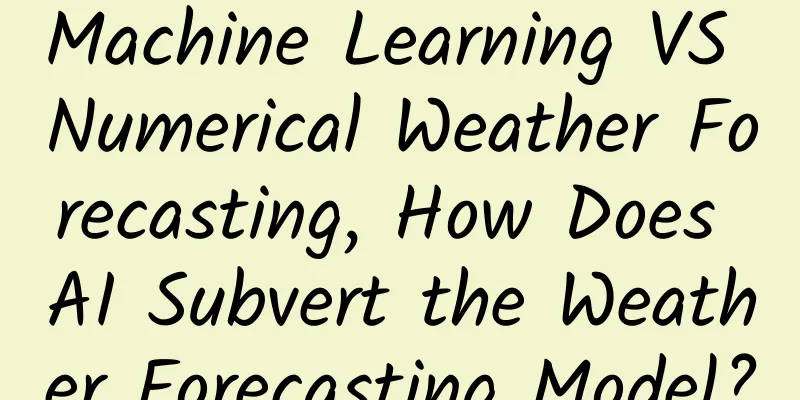Machine Learning VS Numerical Weather Forecasting, How Does AI Subvert the Weather Forecasting Model?

|
Numerical weather forecasting is the mainstream method of weather forecasting. It uses numerical integration to solve the state of the earth system grid by grid, which is a process of deductive reasoning. However, as the resolution of weather forecasts continues to increase and the forecast time gradually increases, the computing power required for NWP models has increased rapidly, limiting its development. On the other hand, data-driven weather forecasting based on artificial intelligence has developed rapidly and has surpassed traditional methods in some areas. How accurate are existing machine learning weather forecasts? How will artificial intelligence change weather forecasts? This article compares several data-driven machine learning weather forecast models and looks forward to the future development of weather forecasts. Author | Xuecai Editor | Sanyang Numerical Weather Prediction: 45 Billion Partial Differential Equations Numerical Weather Prediction (NWP) is the mainstream method in the field of weather forecasting. As early as the beginning of the 20th century, Abbe and Bjerknes proposed that people could use physical laws to predict the weather, taking the current weather conditions as the initial value and integrating them to solve the future weather. However, at that time, the research on meteorology was not in-depth enough, and the computing level was relatively backward, so this idea was not realized. In 1950, the University of Plönlingen attempted to use the first electronic computer to conduct weather forecasting. In 1954, the first real-time weather forecast was achieved in Stockholm. Solve a system of differential equations based on the laws of physics in each mesh cell It was not until the advent of supercomputers in the 1970s that people were able to solve the full set of equations proposed by Abbe and Bjerknes. In 1979, the European Centre for Medium-Range Weather Forecasts (ECMWF) compiled the first medium-range weather forecast, opening the chapter of the Integrated Forecasting System (IFS). However, Edward N. Lorenz summarized the experience of his predecessors and proposed that the weather system is a chaotic system that will undergo huge changes due to slight changes in variables. On the other hand, it is difficult for people to fully grasp the initial state of the meteorological system. For this reason, the academic community uses ensemble forecasting to minimize the uncertainty of initial parameters and forecast models. The collection of forecast results is the basis of probabilistic forecasting. Schematic diagram of ensemble forecast of precipitation probability With the development of technologies such as numerical models, supercomputing, data assimilation and ensemble prediction, the accuracy of numerical weather forecasts has been continuously improved, and the prediction time has gradually increased from 3 days and 5 days to 7 days or even 10 days. The evolution of weather forecasting technology over time in the Northern and Southern Hemispheres (SH, NH) Currently, the forecast model of the European Centre for Medium-Range Weather Forecasts needs to make 10-day forecasts for 2 million grids in each horizontal layer with a step length of 10 minutes, and run twice a day. Therefore, they need to complete the calculation of about 40 billion grids in 2.5 hours, which requires high computing costs. The high computational cost has hindered the further development of numerical weather forecasting methods. How to find a balance between model resolution and ensemble size has become a shackle limiting ensemble forecasting. The rise of data-driven machine learning approaches Recently, data-driven machine learning (ML) has shown great potential in weather forecasting. Since 2022, machine learning models in the field of weather forecasting have made a series of breakthroughs, some of which can rival the high-precision forecasts of the European Centre for Medium-Range Weather Forecasts. Data-driven weather forecast reasoning relies on machine learning models rather than physical models in the Integrated Forecast System (IFS), and its prediction speed is several orders of magnitude faster than traditional methods. In addition, machine learning-based weather forecasts are the result of inductive reasoning rather than traditional deductive reasoning. This paradigm shift in logic changes the way weather forecasts are interpreted - these results are learned from previous data and are therefore more convincing. Dataset: 0.25° reanalysis data from 1940 to present The emergence of data-driven models is due to large-scale, high-quality open meteorological datasets. Existing machine learning weather forecast models are trained on the fifth generation of reanalysis data from the European Centre for Medium-Range Weather Forecasts, the ERA5 reanalysis dataset. When the current version of the Integrated Forecast System (IFS) was launched in 2016, weather data from 1940 to the present were reanalyzed to obtain the ERA5 dataset with a resolution of 0.25° (30 km). FourCastNet: A DL model with comparable accuracy to IFS In 2022, NVIDIA released FourCastNet, which performed the first deep learning weather forecast with a resolution of 0.25° based on the Fourier prediction neural network. FourCastNet architecture diagram While improving the resolution, FourCastNet is not far behind traditional numerical weather forecasting in terms of anomaly correlation coefficient (ACC) and root mean square error (RMSE). Comparison of ACC and RMSE between FourCastNet and numerical weather prediction In terms of node-hours, FourCastNet is approximately 45,000 times faster than traditional numerical weather prediction models. Combined with its accuracy at high resolution, it rapidly reduces the cost of large-scale ensemble forecasts. GraphCast: Global Medium-Term Weather Forecast Based on GNN GraphCast is a neural network based on graph neural network (GNN) with an "encode-process-decode" configuration and a total of 36.7 million parameters. The encoder maps the variables in the input grid to the internal multi-grid through a single layer GNN. The multigrid is a spatially homogeneous graph with global high resolution. The multigrid is formed by 6 iterations of a regular icosahedron (containing 12 nodes, 20 faces and 30 edges), each iteration refining the mesh by dividing a single triangle into 4 smaller triangles and projecting their nodes onto the sphere. The final multigrid contains 40,962 nodes and edges of all the graphs during the refinement process, forming a hierarchical graph with edges of different lengths. The processor uses 16 non-shared GNN layers to perform message passing on multiple grids. The decoder uses a single-layer GNN to map the processor's learned features from multiple grids back to the latitude and longitude system. GraphCast Framework ac: GraphCast’s input-prediction-iteration process; df: GraphCast encoding-processing-decoding configuration; g: Multi-grid refinement process. Compared with the High Resolution Forecast (HRES) of the European Medium-Range Weather Forecast, GraphCast outperforms both in ACC and RMSE. Comparison of prediction RMSE (a&b) and ACC (c) between GraphCast and HRES After 3 weeks of training on 32 Cloud TPU v4 devices, GraphCast was trained on ERA5 data since 1979. GraphCast can then generate a 10-day weather forecast with a resolution of 0.25° and a 6-hour interval in 60 seconds on a single Cloud TPU v4 device. Pangu: A large 3D meteorological model based on ViT The input and output of the Pangu Meteorological Model are both three-dimensional meteorological fields. Due to the uneven distribution of longitude and latitude of the meteorological field, the Pangu Meteorological Model uses a three-dimensional Vision Transformer (ViT) to process meteorological data, and its accuracy exceeds that of the mainstream Integrated Forecast System (IFS) for the first time. 3D Vision Transformer Architecture When the forecast time is longer than 3 days, from the perspective of RMSE, the performance of Pangu Meteorological Model and IFS is comparable, and both are better than the training set ERA5. Comparison of prediction performance of different models for T850 and Z500 a&b: RMSE when different models predict T850 and Z500 respectively; c&d: activity intensity predicted by different models at T850 and Z500, respectively; e&f: Deviations when different models predict T850 and Z500, respectively. In summary, data-driven machine learning weather forecasting is close to the traditional numerical weather forecasting model in terms of prediction accuracy, but the computing equipment and computing speed far exceed the numerical weather forecasting model, which shows that AI weather forecasting has considerable potential in practical applications. Machine Learning and Numerical Prediction = Accuracy + Speed Machine learning is advancing at an incredible pace, both inside and outside of weather forecasting. The European Centre for Medium-Range Weather Forecasts has been keeping an eye on the rapid rise of data-driven weather forecasting, along with NVIDIA, Huawei, and Deepmind. “FourCastNet is the first AI-based weather forecast system with a resolution of 0.25° and the first open source weather forecast system. Our new version significantly improves the medium-term performance and long-term stability of the model, and hopes to achieve super-resolution through a neural operator framework,” said Anima Anandkumar of the NVIDIA Earth-2 team. ECMWF presents these machine learning models, together with stable numerical models, to users, inviting them to evaluate the operation and performance of the systems from the application side. The accuracy, reliability, uncertainty and interactivity of the models are key factors in assessing the quality and effectiveness of meteorological products. To this end, the European Centre for Medium-Range Weather Forecasts has made public the prediction results of FourCastNet, PGW and GraphCast based on IFS initial conditions. Florian Pappenberger said, "Openness is the key to innovation, cooperation and exploration. By sharing data, methods and results, and comparing and analyzing them, we can accelerate scientific development and ultimately benefit society." Three public data of meteorological AI In the comparison of the European Center for Medium-Range Weather Forecasts, it can be seen that AI-based weather forecasts are comparable to numerical weather forecasts in some aspects and will play an important role in the future. However, these models do not yet have comprehensive forecasting capabilities, which is the key to providing valuable forecasts on a medium- to long-term scale. Open access, optimized comparison, portable and easy to obtain, AI is infiltrating its advantages into traditional weather forecasting. While freeing weather forecasting from supercomputers, AI also has a good performance in extreme climate events. I believe that AI can revolutionize weather forecasting together with numerical weather forecasting and contribute to the development of agriculture, forestry, animal husbandry, fishery, navigation and aerospace. Reference Links: [1]https://journals.ametsoc.org/view/journals/mwre/29/12/1520-0493_1901_29_551c_tpbolw_2_0_co_2.xml [2]https://cir.nii.ac.jp/crid/1573668925699683328 [3]https://www.nature.com/articles/nature14956 [4]https://arxiv.org/abs/2202.11214 [5]https://arxiv.org/abs/2212.12794 [6]https://phys.org/news/2023-09-ai-weather-showcase-data-driven.html [7]https://arxiv.org/abs/2307.10128 -- over-- |
<<: "Dragon and egg coexistence" wonder! A 190 million-year-old dinosaur egg nest was discovered →
>>: YaYaYa! The 280th Danxia flyer turned out to be this one!
Recommend
New study! Even if Helicobacter pylori is eradicated, the risk of gastric cancer still exists!
Gastric cancer, as one of the malignant tumors wi...
A brief discussion on the relationship between iOS, Android, Unix and Linux
First, let's look at the time when several sy...
MONA M03, Xpeng Motors’ savior or troublemaker?
Suddenly, like a spring breeze, many brands becam...
He was snoring like thunder, but he was sound asleep, and I couldn't stand it anymore...
If I am guilty, please let the law punish me, ins...
Insights on the major mobile advertising platforms in Q1 2019!
This article takes the five major mainstream plat...
7 skills you need to acquire as an app operator
As a type of Internet operation , App operation c...
In the dark and cold northernmost part of the earth, a group of dinosaurs once thrived
The name Dinosauria was formally proposed by Brit...
H5 production key points and full-process auxiliary tools recommended!
Although short videos are currently very popular,...
Wanbo Brothers Long Legs Fighting Method - Changing Hands Space Legs 1 PDF Article
Wanbo Brothers Long Legs Fighting Method - Changi...
Is "old cold legs" caused by not wearing long underwear? The temperature is about to warm up, can we take off the long underwear?
Review expert: Peng Guoqiu, deputy chief physicia...
What kind of grass is this two-meter-high grass on the grave?
The popularity of customs such as planting willow...
How much does it cost to develop a hotel mini program in Wenshan?
For entrepreneurs, although mini program developm...
Taking Kaola.com as an example, we analyze the event planning process and innovative gameplay
I won’t keep you in suspense here, let me go thro...
Why is it that some people can fall asleep no matter how noisy it is, while others wake up at the slightest noise?
One minute with the doctor, the postures are cons...









